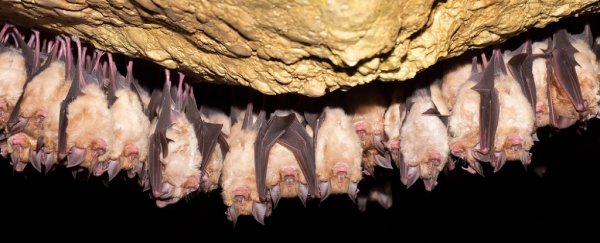When it struck, the contagion spread fiercely. The deadly severe acute respiratory syndrome (SARS) outbreak in South China in 2002 infected thousands, and ultimately killed nearly 800 people.
But where did this lethal strain come from? We may now have our answer, with a study showing bats living in a single cave in China possess all the building blocks of the deadly SARS coronavirus – and potentially the means to create a new one.
Researchers from the Chinese Academy of Sciences spent five years analysing SARS viruses found in multiple species of horseshoe bats nesting in a cave in China's Yunnan Province.
In all, the team identified 11 new strains of SARS virus carried by the bats, and a genomic analysis of these – along with strains from the same cave identified in previous research – revealed something interesting.
Previous research had suggested bat viruses could have been responsible for SARS, but scientists had never uncovered evidence of a direct ancestor to the human-infecting coronavirus in bat strains.
In the new research, that held true again – none of the viruses from the cave by themselves displayed the genetic traits of the SARS coronavirus that spread to humans, infecting more than 8,000 people during the 2002-2003 emergency.
But together, it was a different story. In this one cave, there were enough genetic ingredients among the strains to build the virus that kills humans.
"Importantly, all of the building blocks of SARS-CoV genome, including the highly variable S gene, ORF8 and ORF3, could be found in the genomes of different SARSr-CoV strains from this single location," the researchers explain in their paper.
Hypothetically speaking, the team suggests it's possible – even probable – that if the right strains mixed with one another in the cave, you'd end up with the direct ancestor of a virus that can infect and kill people.
"[W]e speculate that the direct ancestor of SARS-CoV may have arisen from sequential recombination events between the precursors of these bat SARSr-CoVs prior to spillover to an intermediate host," the researchers write.
Of course, it's only a hypothesis for now – although one that's been described as 99 percent persuasive by at least one Chinese virologist uninvolved with the research.
If the virus recombination idea is solid, what we still don't know is how the deadly strain travelled from the cave in Yunnan Province to Guangdong Province, which is some 1,000 kilometres (621 miles) or so distant.
Explaining that might help us authoritatively pin down all the precursors that gave birth to SARS, but for now, there's something more pressing to investigate.
Experiments in the lab suggest that three of the newly discovered SARS bat strains could have the potential to infect human cells much like their deadly predecessor did – courtesy of S protein sequences capable of infecting our ACE2 receptor.
There's no need to panic, but it just goes to show that while research into viruses like SARS may seem to focus on how past outbreaks were possible, it's only so we can prevent future deaths via the same vectors.
"[Viruses] are poised to cause future outbreaks," virologist Ralph Baric from the University of North Carolina, who was not involved in the study, told Science News. "We can't let our guard down."
The findings are reported in PLOS Pathogens.
